It is important to distinguish between sex and gender. Sex refers to a person's biological make-up as male or female. Typically, a person's genotype (genetic makeup) and phenotype (observable traits) are used to determine a person's sex. Males are defined as having an XY 23rd chromosome, while females are defined as having an XX 23rd chromosome (though tests have revealed variations in chromosomes, including XXY, XYY, and XXX). Scientists have linked a person's 23rd chromosome to the development of a sexed phenotype. Anatomically, males and females have different reproductive organs: a penis, testicles, and scrotum for males, and a vagina, uterus, and ovaries for females. Other anatomical differences include the development of breasts among females, and the presence of a menstrual cycle.
Male and female are generally understood as discrete categories, often referred to as "opposite" sexes. In fact, the majority of male and female biology is identical. Male and female reproductive systems are distinct, but otherwise most bodily systems function the same way. With regards to digestive, respiratory, circulatory, lymphatic, musculoskeletal, nervous, immune, sensory, endocrine, and integumentary systems, males and females have many more similarities than differences. Likewise, males and females have nearly all the same hormones present in their bodies, though the amount of certain hormones (such as estrogen and testosterone) varies.
While sex is the determination of whether a person is biologically male or female, gender is the sociocultural determination of
understanding of what it means to be a man or a woman. Sex is largely constant across different cultures; in virtually any country, a person with XY chromosomes and male reproductive organs is considered male. Gender, however, takes many forms and is shaped by religious, political, legal, philosophical, linguistic, and other traditions. For example, in some countries, wearing make-up is associated with women and is seen as feminine. Elsewhere, men routinely wear make-up and it is seen as masculine. Across history in most parts of the world, women have been denied access to economic independence and legal and political rights more often than men have. This oppression is based on cultural understandings of women as the weaker sex, but is often linked to females' biological capacity for bearing and nursing children.
Some physical differences between the male and female sexes are thought to occur as a result of both biological and cultural processes. For example, on average, males have more upper body strength than females. This difference is partially the result of differences in the biological development of the musculoskeletal system, but is exacerbated by the cultural tendency for men to use their upper body muscles more than women through physical labor and athletics . Similarly, males have a shorter life expectancy than females do, on average. Again, this may partially result from different biological make-ups, but decreased life-expectancy gaps in developed countries proves that cultural institutions contribute to the gap. When men and women have similar careers and lifestyles, the life-expectancy gap decreases.

The Male Anatomy
The male reproductive system is clearly distinct from that of the female.